Telegram from Richard Henry Pratt to the Commissioner of Indian Affairs, relaying a message from ticket agent W. F. White in Wichita, Kansas that he is unable to arrange the transportation plans requested by the Commissioner. Alternative transportation plans are suggested.
1879
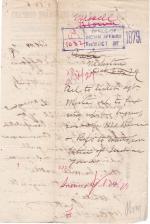
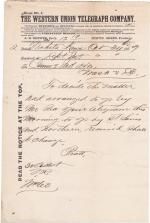
Telegram from Richard Henry Pratt to the Commissioner of Indian Affairs, asking whether the party of pupils should be transported via the Northern Pacific Railroad line as initially planned, or the St. Louis and Northern Railroad line as received.
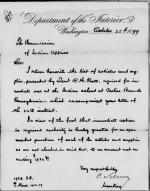
Secretary of the Interior Carl Schurz returns a list of articles and supplies requested by Richard Henry Pratt for the Carlisle Indian School. Schurz grants immediate authority to make open market purchase of the requested supplies amounting to $1,972.
Note: This item was copied from U.S. National Archives microfilm reels (M234), which…
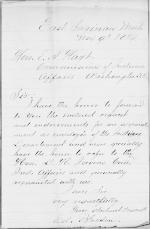
Edward Bloeden writes to Commissioner of Indian Affairs E. A. Hayt to request employment at the Carlisle Indian School. He specifically refers to being a "steward" of the school.
Note: This item was copied from U.S. National Archives microfilm reels (M234), which were filmed from the original documents found in Record Group 75, Entry 79…
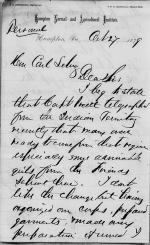
Hampton Institute Principal Samuel C. Armstrong informs Secretary of the Interior Carl Schurz that he received a telegraph from Captain Richard H. Pratt, who is currently in the Indian Territory. Pratt stated that there are many Indian girls in the Indian Territory who would be suitable students at Hampton. Armstrong states that, though he…
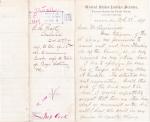
Letter from Richard Henry Pratt to Commissioner of Indian Affairs Ezra Hayt, acknowledging receipt of change orders allowing Pratt to remain in the East at the Carlisle Indian School. Pratt also apologizes for troubles during his recent trip to Wichita, and suggests that better planning be made for subsequent recruitment trips. Student…
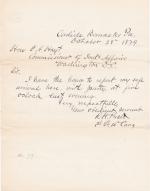
Richard Henry Pratt writes to Commissioner of Indian Affairs Ezra Hayt, informing him that his party of recruited students, met and delayed in Wichita, Kansas, safely arrived in Carlisle the previous evening.
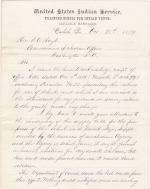
Superintendent Richard Henry Pratt writes to Commissioner of Indian Affairs Ezra Hayt regarding Circular No. 33, regarding rations for Indian pupils. Pratt suggests that this ration rate is insufficient given Carlisle's current nascent state, and requests permission to continue using the Army's rationing tables instead.
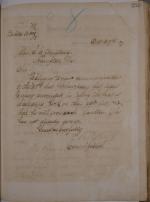
Commissioner of Indian Affairs Ezra A. Hayt writes to Samuel Chapman Armstrong at Hampton to report that Indian Agent Charles Crissey left Standing Rock and will likely reach Yankton soon.

Telegram from Richard Henry Pratt asking the Commissioner of Indian Affairs for permission to travel to Washington the subsequent day.

Anna H. Haines asks Secretary of the Interior Carl Schurz if an Indian boarding school has been established in Carlisle. If so, she asks to be appointed as matron for the school.

Secretary of the Interior Carl Schurz grants Richard Henry Pratt authority to purchase a list of supplies amounting to $1,998.25 on the open market. The list of supplies mostly includes bedding, furniture, and kitchen supplies.
Note: This item was copied from U.S. National Archives microfilm reels (M234), which were filmed from the…
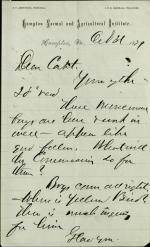
Samuel Chapman Armstrong of the Hampton Institute writes to Richard Henry Pratt discussing recently arrived Menominee boys, and inquires about Yellow Bird.
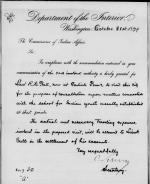
Secretary of the Interior Carl Schurz grants authority for Richard Henry Pratt to visit Washington, D.C. to discuss the newly-established Carlisle Indian School.
Note: This item was copied from U.S. National Archives microfilm reels (M234), which were filmed from the original documents found in Record Group 75, Entry 79, "Letters…
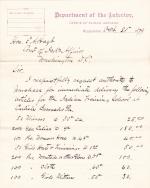
Richard Henry Pratt writes to Commissioner of Indian Affairs Ezra A. Hayt requesting authority to purchase personal supplies for students, including clothing and toiletries for both males and females.
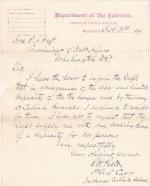
Richard Henry Pratt requests that a cooking range with a 300-person capacity be supplied to the Carlisle Indian School.

Richard Henry Pratt writes to Commissioner of Indian Affairs Ezra A. Hayt requesting authority to purchase dormitory furniture immediately needed at the Carlisle Indian School.

A card which records Richard Henry Pratt's appointment as Superintendent of an "Industrial School for Indians at Carlisle, Pa." Another note on the card indicates that Pratt's appointment was "transferred from the Appointment Division to the Indian Division" in December of 1888.
A page that accompanies this card indicates that Pratt's…
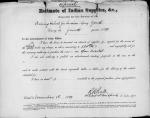
Richard H. Pratt submits a "Special" Estimate of Supplies for the fourth quarter of fiscal year 1879 amounting to $24.99, allowing Pratt to purchase postage stamps. The form includes a note that the postage stamps will allow students to write to their family and friends. An explanatory cover letter is included
Note: This item was copied…

Samuel Chapman Armstrong of the Hampton Institute writes to Richard Henry Pratt about transferring some students, including Menominee boys and Yellow Bird, to Carlisle. Armstrong also discusses a visit to Carlisle on a trip north.
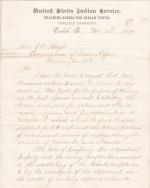
Richard Henry Pratt writes to Commissioner of Indian Affairs Ezra Hayt, requesting $4000 be transferred to his credit for the purposes of settling debts and paying owed salaries. A note in the file suggests that the Commissioner had a total of $7000 transferred into Pratt's account.
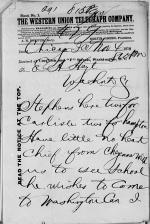
Agent Charles Crissey informs Commissioner of Indian Affairs E. A. Hayt that Agent Stephens is there with two students for the Carlisle Indian School and two for Hampton Institute. Crissey notes that he is also with Cheyenne Chief Little No Heart, who would like see the school. Crissey asks if he can bring Little No Heart with him.
Note…
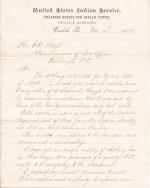
Richard Henry Pratt writes to Commissioner of Indian Affairs Ezra Hayt, requesting permission to spend $1000 on cold weather clothing for students. Pratt notes that supplies requested two months previous had not yet arrived, and that cold weather had set in at Carlisle.
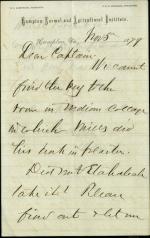
Samuel Chapman Armstrong of the Hampton Institute writes to Richard Henry Pratt inquiring whether Etadleuh still has the key to the Medium Cottage where Clark Mills took plaster casts of the heads of prisoners from Ft. Marion. Armstrong also discusses Hampton's capacity for Indian students.

Spencer Fullerton Baird of the Smithsonian Institution writes to Richard Henry Pratt offering to transfer Tichkematse to Carlisle, and extends his support for Pratt's efforts at Carlisle in Congress.
